unit 6Do you like bananas 单元知识点复习课件(共22张PPT)人教版七年级上册
文档属性
| 名称 | unit 6Do you like bananas 单元知识点复习课件(共22张PPT)人教版七年级上册 |  | |
| 格式 | pptx | ||
| 文件大小 | 136.2KB | ||
| 资源类型 | 教案 | ||
| 版本资源 | 人教新目标(Go for it)版 | ||
| 科目 | 英语 | ||
| 更新时间 | 2023-12-27 13:20:16 | ||
图片预览

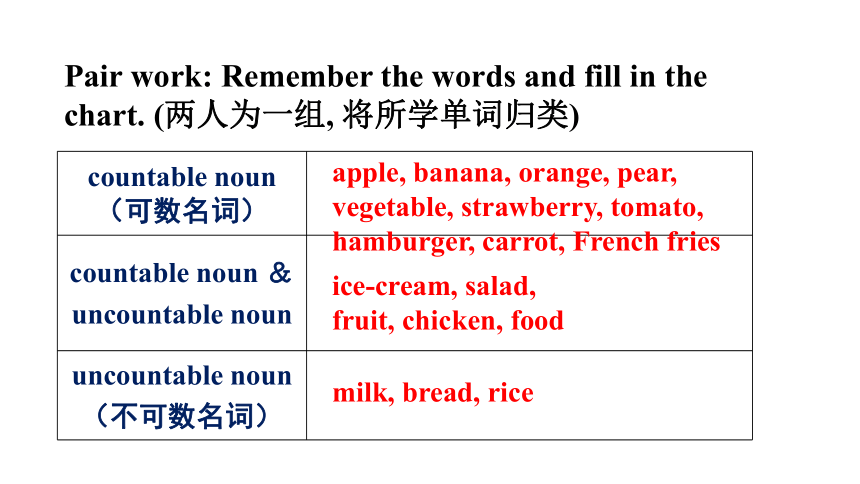
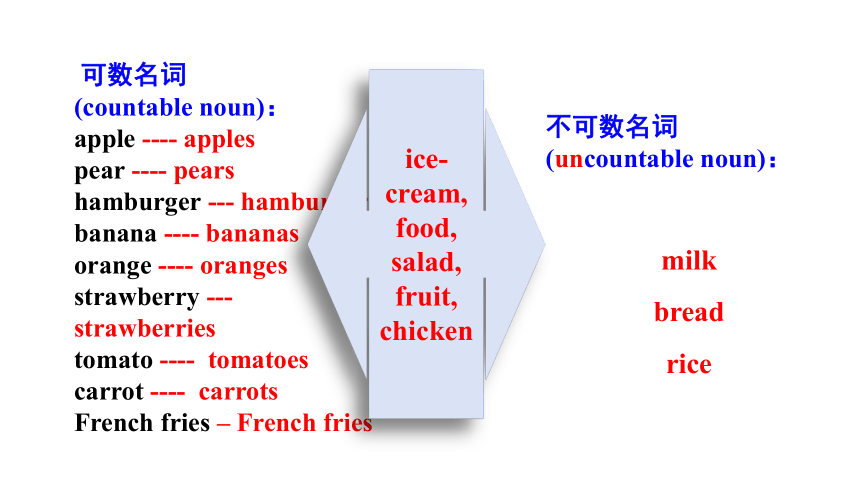
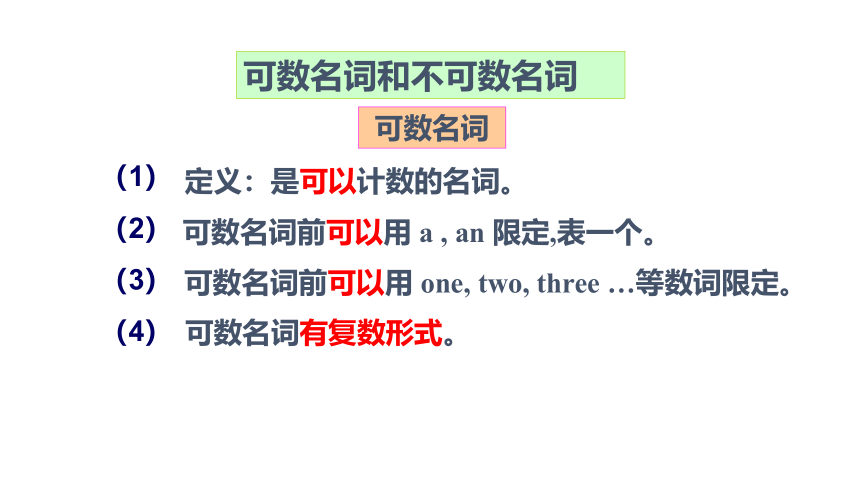
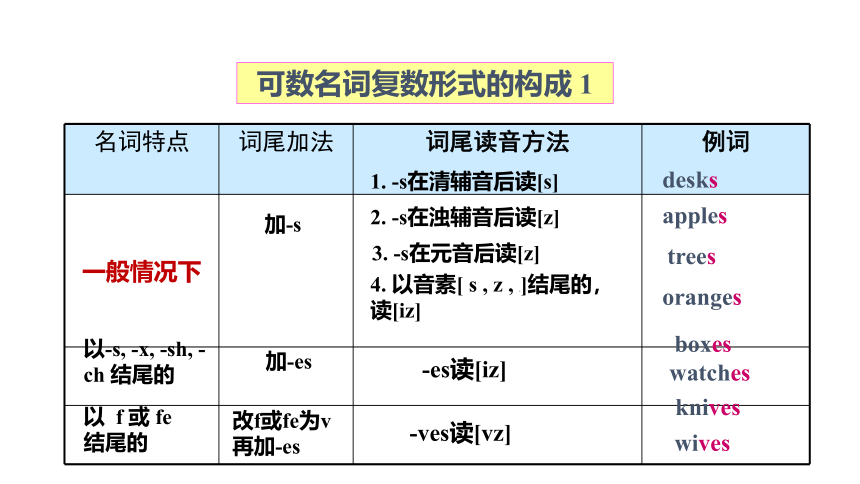

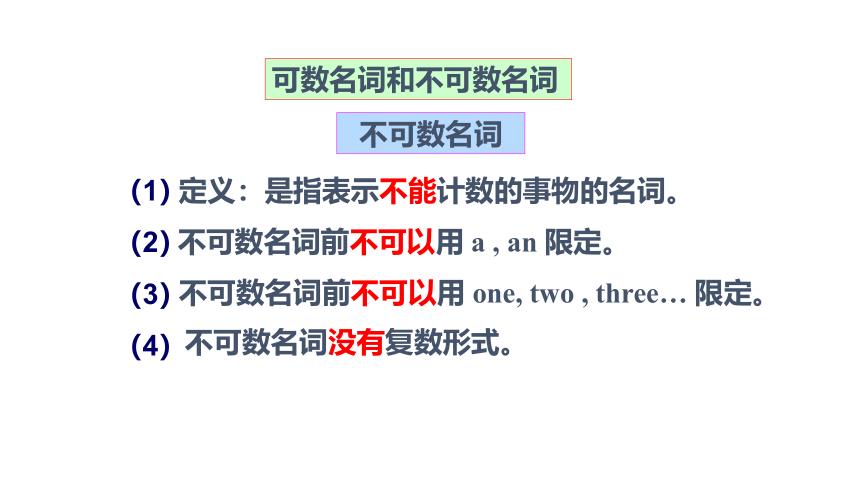
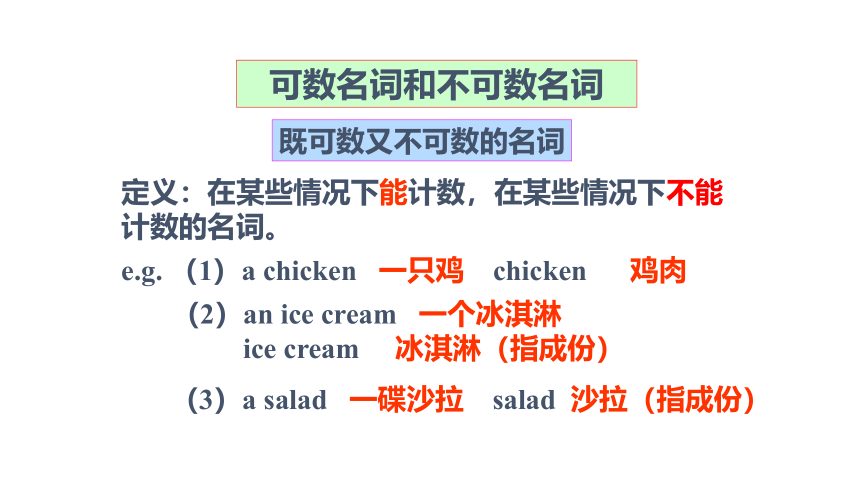
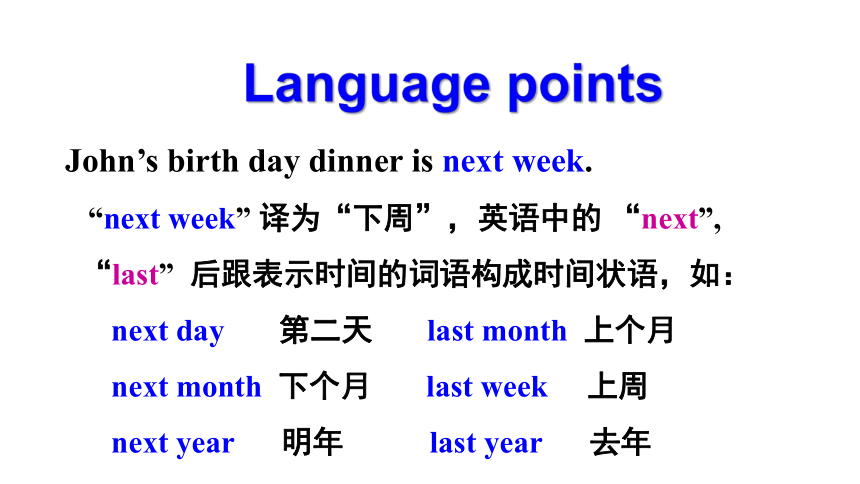
文档简介
(共22张PPT)
单元知识点复习课件
Unit 6 Do you like bananas
Pair work: Remember the words and fill in the chart. (两人为一组, 将所学单词归类)
countable noun(可数名词)
countable noun & uncountable noun
uncountable noun (不可数名词)
apple, banana, orange, pear, vegetable, strawberry, tomato, hamburger, carrot, French fries
ice-cream, salad,
fruit, chicken, food
milk, bread, rice
可数名词 (countable noun):
apple ---- apples pear ---- pears hamburger --- hamburgers banana ---- bananas orange ---- oranges strawberry --- strawberries tomato ---- tomatoes
carrot ---- carrots
French fries – French fries
不可数名词 (uncountable noun):
milk
bread
rice
ice-cream, food,
salad, fruit, chicken
可数名词和不可数名词
可数名词
(1)
(2)
(3)
(4)
定义:是可以计数的名词。
可数名词前可以用 a , an 限定,表一个。
可数名词前可以用 one, two, three …等数词限定。
可数名词有复数形式。
名词特点 词尾加法 词尾读音方法 例词
一般情况下
可数名词复数形式的构成 1
加-s
1. -s在清辅音后读[s]
2. -s在浊辅音后读[z]
3. -s在元音后读[z]
4. 以音素[ s , z , ] ]结尾的,读[iz]
desks
apples
trees
oranges
以-s, -x, -sh, -ch 结尾的
加-es
-es读[iz]
boxes
watches
以 f 或 fe 结尾的
改f或fe为v 再加-es
-ves读[vz]
knives
wives
可数名词复数形式的构成 2
名词特点 词尾加法 词尾读音方法 例词
改y为i 再加-es
-ies读[iz]
families
dictionaries
以元音字母
加y结尾的
加-s
-s读[z]
boys
keys
以o 结尾的
有生命的事物加-es
-es读[z]
tomatoes
potatoes
以辅音字母加y结尾的
无生命的事物加-s
-s读[z]
photos
radios
可数名词和不可数名词
不可数名词
(1)
(2)
(3)
(4)
定义:是指表示不能计数的事物的名词。
不可数名词前不可以用 a , an 限定。
不可数名词前不可以用 one, two , three… 限定。
不可数名词没有复数形式。
可数名词和不可数名词
既可数又不可数的名词
定义:在某些情况下能计数,在某些情况下不能计数的名词。
e.g. (1)a chicken 一只鸡 chicken 鸡肉
(2)an ice cream 一个冰淇淋
ice cream 冰淇淋(指成份)
(3)a salad 一碟沙拉 salad 沙拉(指成份)
Language points
John’s birth day dinner is next week.
“next week” 译为“下周”,英语中的 “next”, “last” 后跟表示时间的词语构成时间状语,如:
next day 第二天 last month 上个月
next month 下个月 last week 上周
next year 明年 last year 去年
Let’s think about the food.
让我们来想想(吃什么)食物吧。
“think about”表示“思考;考虑”, “think” 为不及物动词,常与介词 about连用。例如:
Let me think about your house.
让我考虑考虑你的房子问题。
How about...?意为“……怎么样?”
相当于What about...?,用来询问情况或征求意见。如:How about/What about eating salad
吃沙拉怎么样?
My father is a teacher. What about yours
我的父亲是位老师,你父亲呢?
Let’s have strawberries and apples then.
“Let’s have...”译为“让我们吃……”
1) 在英语中“have”+表示一日三餐的名词,意为“用餐”。
have breakfast/lunch/supper 吃早饭/午饭/晚饭
have dinner 吃晚饭
2)have+表示食品、饮料等的名词,
意为“吃;喝”
(=eat, drink)。如:
have (some) bread 吃面包
have eggs (for breakfast) (早餐)吃鸡蛋
have (a cup of )tea 喝(一杯)茶
some和many 的区别
(1) some 意思是 “一些”, 可以修饰可数名词, 也可以
修饰不可数名词。
e.g. some friends 一些朋友 some water 一些水
(2) many 后加可数名词复数, 意思是 “许多”。不可数名词
要用much修饰。
e.g. many bananas 许多香蕉 much milk 许多牛奶
volleyball 排球
volleyballer 排球运动员
后缀-er一般用来表示人。
e.g. work (工作) --- worker(工人)
sing(唱歌) --- singer(歌手)
teach (教) --- teacher(教师)
run (跑) ---runner(跑步的人)
I like chicken for dinner. 晚餐我喜欢吃鸡肉。
for dinner在句中作状语。
2) have /has也可以表示 “吃”或 “喝”。
英语中人们习惯用have来表示吃早、中、晚饭。
而不用eat来表示, 且三餐前不加定冠词the。
e.g. Let’s have lunch. 我们吃午饭吧。
Let’s have some salad.
让我们吃些沙拉吧。
4. I don’t want to be fat. 我不想变胖。
want的用法:
want sth. 想要某物
want to do sth. 想要做某事
want sb. to do sth. 想要某人做某事
e.g. I want some water.
I want to eat an apple.
He wants his mother to have a rest.
do 表示
动词原形
1.当主语是第一、二人称单复数和第三人称复数时, 肯定句
的谓语由动词原形充当。否定句的谓语为don’t+动词原形。
一般疑问句句首用Do, 句中的谓语用动词原形。
e.g. I like tomatoes.
I don’t like hamburgers.
Do you like tomatoes
Simple present tense—like
Language points
2. 在一般现在时中, 当主语是第三人称单数时, 其
肯定句的谓语由动词原形+s(es)构成。
否定句的谓语由doesn’t+动词原形构成。
一般疑问句句首用does, 句中的谓语用动词原形充当。
e.g. She likes apples.
She doesn’t like chicken.
Does she like apples
肯定句
I/you/we/they like French fries.
He/she likes ice-cream.
否定句
I /you/we/they don’t like tomatoes.
He/she doesn’t like French fries.
动词“like”的肯定句、否定句的用法
一般疑问句的肯定/否定回答
—Do you like hamburgers
—Yes, I do. / No, I don’t.
—Does he/she like broccoli
—Yes, he/she does.
/No, he/she doesn’t.
Practice the conversation with
your partner.
A: Do you like oranges
B: No, I don’t.
A: Do you like bananas
B: Yes, I do.
单元知识点复习课件
Unit 6 Do you like bananas
Pair work: Remember the words and fill in the chart. (两人为一组, 将所学单词归类)
countable noun(可数名词)
countable noun & uncountable noun
uncountable noun (不可数名词)
apple, banana, orange, pear, vegetable, strawberry, tomato, hamburger, carrot, French fries
ice-cream, salad,
fruit, chicken, food
milk, bread, rice
可数名词 (countable noun):
apple ---- apples pear ---- pears hamburger --- hamburgers banana ---- bananas orange ---- oranges strawberry --- strawberries tomato ---- tomatoes
carrot ---- carrots
French fries – French fries
不可数名词 (uncountable noun):
milk
bread
rice
ice-cream, food,
salad, fruit, chicken
可数名词和不可数名词
可数名词
(1)
(2)
(3)
(4)
定义:是可以计数的名词。
可数名词前可以用 a , an 限定,表一个。
可数名词前可以用 one, two, three …等数词限定。
可数名词有复数形式。
名词特点 词尾加法 词尾读音方法 例词
一般情况下
可数名词复数形式的构成 1
加-s
1. -s在清辅音后读[s]
2. -s在浊辅音后读[z]
3. -s在元音后读[z]
4. 以音素[ s , z , ] ]结尾的,读[iz]
desks
apples
trees
oranges
以-s, -x, -sh, -ch 结尾的
加-es
-es读[iz]
boxes
watches
以 f 或 fe 结尾的
改f或fe为v 再加-es
-ves读[vz]
knives
wives
可数名词复数形式的构成 2
名词特点 词尾加法 词尾读音方法 例词
改y为i 再加-es
-ies读[iz]
families
dictionaries
以元音字母
加y结尾的
加-s
-s读[z]
boys
keys
以o 结尾的
有生命的事物加-es
-es读[z]
tomatoes
potatoes
以辅音字母加y结尾的
无生命的事物加-s
-s读[z]
photos
radios
可数名词和不可数名词
不可数名词
(1)
(2)
(3)
(4)
定义:是指表示不能计数的事物的名词。
不可数名词前不可以用 a , an 限定。
不可数名词前不可以用 one, two , three… 限定。
不可数名词没有复数形式。
可数名词和不可数名词
既可数又不可数的名词
定义:在某些情况下能计数,在某些情况下不能计数的名词。
e.g. (1)a chicken 一只鸡 chicken 鸡肉
(2)an ice cream 一个冰淇淋
ice cream 冰淇淋(指成份)
(3)a salad 一碟沙拉 salad 沙拉(指成份)
Language points
John’s birth day dinner is next week.
“next week” 译为“下周”,英语中的 “next”, “last” 后跟表示时间的词语构成时间状语,如:
next day 第二天 last month 上个月
next month 下个月 last week 上周
next year 明年 last year 去年
Let’s think about the food.
让我们来想想(吃什么)食物吧。
“think about”表示“思考;考虑”, “think” 为不及物动词,常与介词 about连用。例如:
Let me think about your house.
让我考虑考虑你的房子问题。
How about...?意为“……怎么样?”
相当于What about...?,用来询问情况或征求意见。如:How about/What about eating salad
吃沙拉怎么样?
My father is a teacher. What about yours
我的父亲是位老师,你父亲呢?
Let’s have strawberries and apples then.
“Let’s have...”译为“让我们吃……”
1) 在英语中“have”+表示一日三餐的名词,意为“用餐”。
have breakfast/lunch/supper 吃早饭/午饭/晚饭
have dinner 吃晚饭
2)have+表示食品、饮料等的名词,
意为“吃;喝”
(=eat, drink)。如:
have (some) bread 吃面包
have eggs (for breakfast) (早餐)吃鸡蛋
have (a cup of )tea 喝(一杯)茶
some和many 的区别
(1) some 意思是 “一些”, 可以修饰可数名词, 也可以
修饰不可数名词。
e.g. some friends 一些朋友 some water 一些水
(2) many 后加可数名词复数, 意思是 “许多”。不可数名词
要用much修饰。
e.g. many bananas 许多香蕉 much milk 许多牛奶
volleyball 排球
volleyballer 排球运动员
后缀-er一般用来表示人。
e.g. work (工作) --- worker(工人)
sing(唱歌) --- singer(歌手)
teach (教) --- teacher(教师)
run (跑) ---runner(跑步的人)
I like chicken for dinner. 晚餐我喜欢吃鸡肉。
for dinner在句中作状语。
2) have /has也可以表示 “吃”或 “喝”。
英语中人们习惯用have来表示吃早、中、晚饭。
而不用eat来表示, 且三餐前不加定冠词the。
e.g. Let’s have lunch. 我们吃午饭吧。
Let’s have some salad.
让我们吃些沙拉吧。
4. I don’t want to be fat. 我不想变胖。
want的用法:
want sth. 想要某物
want to do sth. 想要做某事
want sb. to do sth. 想要某人做某事
e.g. I want some water.
I want to eat an apple.
He wants his mother to have a rest.
do 表示
动词原形
1.当主语是第一、二人称单复数和第三人称复数时, 肯定句
的谓语由动词原形充当。否定句的谓语为don’t+动词原形。
一般疑问句句首用Do, 句中的谓语用动词原形。
e.g. I like tomatoes.
I don’t like hamburgers.
Do you like tomatoes
Simple present tense—like
Language points
2. 在一般现在时中, 当主语是第三人称单数时, 其
肯定句的谓语由动词原形+s(es)构成。
否定句的谓语由doesn’t+动词原形构成。
一般疑问句句首用does, 句中的谓语用动词原形充当。
e.g. She likes apples.
She doesn’t like chicken.
Does she like apples
肯定句
I/you/we/they like French fries.
He/she likes ice-cream.
否定句
I /you/we/they don’t like tomatoes.
He/she doesn’t like French fries.
动词“like”的肯定句、否定句的用法
一般疑问句的肯定/否定回答
—Do you like hamburgers
—Yes, I do. / No, I don’t.
—Does he/she like broccoli
—Yes, he/she does.
/No, he/she doesn’t.
Practice the conversation with
your partner.
A: Do you like oranges
B: No, I don’t.
A: Do you like bananas
B: Yes, I do.
同课章节目录
- starters 预备篇(2012秋审查)
- Unit 1 Good morning !
- Unit 2 What’s this in English?
- Unit 3 What color is it ?
- Unit 1 My name's Gina.
- Section A
- Section B
- Unit 2 This is my sister.
- Section A
- Section B
- Unit 3 Is this your pencil?
- Section A
- Section B
- Unit 4 Where's my schoolbag?
- Section A
- Section B
- Unit 5 Do you have a soccer ball?
- Section A
- Section B
- Unit 6 Do you like bananas?
- Section A
- Section B
- Unit 7 How much are these socks?
- Section A
- Section B
- Unit 8 When is your birthday?
- Section A
- Section B
- Unit 9 My favorite subject is science.
- Section A
- Section B
